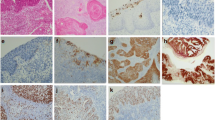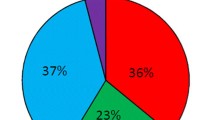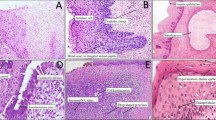Abstract
Cervical cancer is a common and an important public health problem for adult women in developing countries. In contrast, cervical cancer incidence is low in Saudi Arabia. High-risk types of human papilloma viruses (HPV16 and HPV18) are the most significant risk factors for cervical cancer. HPV16/18-E6 oncoprotein is associated with HPV etiology, viral persistence and epithelial transformation. Cell cycle protein p16 INK4a (p16) plays an important role in the pathophysiology of cervical carcinomas. The aims of this study were to investigate the expression of HPV16/18-E6 and p16 in uterine cervical carcinomas in Qassim Region - Saudi Arabia, and to relate the results to the established clinicopathological prognostic parameters (age of the patient, educational level, birth control methods, number of pregnancy, smoking status, degree of histological differentiation, clinical stage, and lymph node metastasis) The study included 40 specimens of uterine cervical squamous cell carcinomas diagnosed and confirmed by biopsy. Histopathological classification of cervical tumors cases was performed according to the International Federation of Gynecology and Obstetrics (FIGO). Immunohistochemical analysis for HPV16/18-E6 and p16 were carried out on formalin-fixed paraffin-embedded sections of cervical tissues using avidin-biotin peroxidase method. There was a significant statistical correlation between HPV16/18-E6 expression in cervical carcinoma and nationality, smoking status and size of the tumor. HPV16/18-E6 oncoprotein expression in normal lymphocytes and endothelial cells in the tumor tissues and the adjacent normal cervical tissues suggest the possibility that HPV infection might spread to other organs through blood circulation. P16 expression has been correlated with high grade, stage of cervical SCC and HPV16/18-E6 expression. The current study supports the critical function of p16 and HPV16/18-E6 as specific markers for cervical carcinoma. However the potential for usage of p16 and HPV16/18-E6 as prognostic markers will require detailed follow data for a larger group of patients.


Similar content being viewed by others
References
Parkin DM, Bray F, Ferlay J, Pisani P (2005) Global cancer statistics 2002. CA Cancer J Clin 55:74–108
Sankaranarayanan R, Madhukar A, Rajkumar R (2001) Effective screening programmes for cervical cancer in low- and middle-income developing countries. Bull World Health Organ 79(10):954–962
GLOBOCAN 2000. Cancer incidence, mortality and prevalence worldwide, version 10. IARC Cancer Base No 5 Lyon, IARC Press. 2001
Bosch FX, de Sanjose S (2003) Human papillomavirus and cervical cancer – burden and assessment of causality. J Natl Cancer Inst Monogr 31:3–13
Walboomers JM, Jacobs MV, Manos MM, Bosch FX, Kummer JA, Shah KV, Snijders PJ, Peto J, Meijer CJ, Muñoz N (1999) Human papillomavirus is a necessary cause of invasive cervical cancer worldwide. J Pathol 189(1):12–19
de Sanjosé S, Diaz M, Castellsagué X, Clifford G, Bruni L, Muñoz N, Bosch FX (2007) Worldwide prevalence and genotype distribution of cervical human papillomavirus DNA in women with normal cytology: a meta-analysis. Lancet Infect Dis 7(7):453–459
Wright TC Jr, Schiffman M (2003) Adding a test for human papillomavirus DNA to cervical- cancer screening. N Engl J Med 348:489
What Causes Cancer of the Cervix?. American Cancer Society (2014-01-31).
Rashed MM, Bekele A (2011) The prevalence and pattern of HPV-16 immunostaining in uterine cervical carcinomas in ethiopian women: a pilot study. Pan Afr Med J 8:21
Missaoui N, Hmissa S, Frappart L, Trabelsi A, Ben Abdelkader A, Traore C, Mokni M, Yaacoubi MT, Korbi S (2006) p16INK4A overexpression and HPV infection in uterine cervix adenocarcinoma. Virchows Arch 448(5):597–603
Bhurgri Y, Bhurgri A, Rahim A, Bhutto K, Pinjani PK, Usman A, Hasan SH (1999) The pattern of malignancies in Karachi (1995 to 1996). J Pak Med Assoc 49:157–161
Altaf F (2001) Pattern of cervical smear cytology in western region of Saudi Arabia. Ann Saudi Med 21:94–96
Jamal A, Al-Maghrabi JA (2003) Profile of pap smear cytology in the Western region of Saudi Arabia. Saudi Med J 24:1225–1229
Raza SA, Franceschi S, Pallardy S, Malik FR, Avan BI, Zafar A, Ali SH, Pervez S, Serajuddaula S, Snijders PJ et al (2010) Human papillomavirus infection in women with and without cervical cancer in Karachi, Pakistan. Br J Cancer 102:1657–1660
Castellsague X, Bosch FX, Munoz N, Meijer CJ, Shah KV, de Sanjose S, Eluf-Neto J, Ngelangel CA, Chichareon S, Smith JS et al (2002) Male circumcision, penile human papillomavirus infection, and cervical cancer in female partners. N Engl J Med 346:1105–1112
Hammouda D, Clifford GM, Pallardy S, Ayyach G, Chekiri A, Boudrich A, Snijders PJ, van Kemenade FJ, Meijer CJ, Bouhadef A et al (2011) Human papillomavirus infection in a population-based sample of women in Algiers, Algeria. Int J Cancer 128:2224–2229
Alsbeih G, Ahmed R, Al-Harbi N, Venturina LA, Tulbah A, Balaraj K (2011) Prevalence and genotypes’ distribution of human papillomavirus in invasive cervical cancer in Saudi Arabia. Gynecol Oncol 121:522–526
Al-Badawi IA, Al-Suwaine A, Al-Aker M, Asaad L, Alaidan A, Tulbah A, Fe Bohol M, Munkarah AR (2011) Detection and genotyping of human papiloma virus in cervical cancer specimens from Saudi patients. Int J Gynecol Cancer 21:907–910
Khorasanizadeh F, Hassanloo J, Khaksar N, Taheri SM, Marzaban M, Rashidi BH, Sari AA, Zendehdel K (2012) Epidemiology of cervical cancer and human papilloma virus infection among Iranian women - analyses of national data and systematic review of the literature. Gynecol Oncol 128:277–281
Hussain S, Bharadwaj M, Nasare V, Kumari M, Sharma S, Hedau S, Das BC (2012) Human papillomavirus infection among young adolescents in India: impact of vaccination. J Med Virol 84:298–305
Al-Muammar T, Al-Ahdal MN, Hassan A, Kessie G, Dela Cruz DM, Mohamed GE (2007) Human papilloma virus-16/18 cervical infection among women attending a family medical clinic in Riyadh. Ann Saudi Med 27:1–5
Duttagupta C, Sengupta S, Roy M, Sengupta D, Bhattacharya P, Laikangbam P, Roy S, Ghosh S, Das R (2004) Are Muslim women less susceptible to oncogenic human papillomavirus infection? a study from rural Eastern India. Int J Gynecol Cancer 14:293–303
de Boer MA, Vet JN, Aziz MF, Cornain S, Purwoto G, van den Akker BE, Dijkman A, Peters AA, Fleuren GJ (2006) Human papillomavirus type 18 and other risk factors for cervicacancer in Jakarta, Indonesia. Int J Gynecol Cancer 16:1809–1814
Alsbeih G, Al-Harbi N, El-Sebaie M, Al-Badawi I (2013) HPV prevalence and genetic predisposition to cervical cancer in Saudi Arabia. Infect Agent Cancer 8(1):15
Ren C, Cheng X, Lu B, Yang G. Activation of interleukin-6/signal transducer and activator of transcription 3 by human papillomavirus early proteins 6 induces fibroblast senescence to promote cervical tumourigenesis through autocrine and paracrine pathways in tumour microenvironment. Eur J Cancer. 2013 Aug 14.
Kaewprag J, Umnajvijit W, Ngamkham J, Ponglikitmongkol M (2013) HPV16 oncoproteins promote cervical cancer invasiveness by upregulating specific matrix metalloproteinases. PLoS One 8(8):e71611
Sano T, Oyama T, Kashiwabara K, Fukuda T, Nakajima T (1998) Expression status of p16 protein is associated with human papillomavirus oncogenic potential in cervical and genital lesions. Am J Pathol 153(6):1741–1748
Bringold F, Serrano M (2000) Tumor suppressors and oncogenes in cellular senescence. Exp Gerontol 35(3):317–329
Lin HP, Wang YP, Chiang CP (2011) Expression of p53, MDM2, p21, heat shock protein 70, and HPV 16/18 E6 proteins in oral verrucous carcinoma and oral verrucous hyperplasia. Head Neck 33:334–340
Amaro-Filho SM, Golub JE, Nuovo GJ, Cunha CB, Levi JE, Villa LL, Andrade CV, Russomano FB, Tristão A, Pires A, Nicol AF (2013) A comparative analysis of clinical and molecular factors with the stage of cervical cancer in a Brazilian cohort. PLoS One 8(3):e57810
Mendoza L, Mongelos P, Paez M, Castro A, Rodriguez-Riveros I, Gimenez G, Araujo P, Echagüe G, Diaz V, Laspina F, Castro W, Jimenez R, Marecos R, Ever S, Deluca G, Picconi MA (2013) Human papillomavirus and other genital infections in indigenous women from Paraguay: a cross-sectional analytical study. BMC Infect Dis 13(1):531
Simonella LM, Lewis H, Smith M, Neal H, Bromhead C, Canfell K (2013) Type-specific oncogenic human papillomavirus infection in high grade cervical disease in New Zealand. BMC Infect Dis 13:114
Cornet I, Gheit T, Iannacone MR, Vignat J, Sylla BS, Del Mistro A, Franceschi S, Tommasino M, Clifford GM (2013) HPV16 genetic variation and the development of cervical cancer worldwide. Br J Cancer 108(1):240–244
Tungteakkhun SS, Duerksen-Hughes PJ (2008) Cellular binding partners of the human papillomavirus E6 protein. Arch Virol 153(3):397–408
Togtema M, Pichardo S, Jackson R, Lambert PF, Curiel L, Zehbe I (2012) Sonoporation delivery of monoclonal antibodies against human papillomavirus 16 E6 restores p53 expression in transformed cervical keratinocytes. PLoS One 7(11):e50730
Lin HP, Wang YP, Chiang CP (2011) Expression of p53, MDM2, p21, heat shock protein 70, and HPV 16/18 E6 proteins in oral verrucous carcinoma and oral verrucous hyperplasia. Head Neck 33(3):334–340
Doorbar J, Quint W, Banks L, Bravo IG, Stoler M, Broker TR, Stanley MA (2012) The biology and life-cycle of human papillomaviruses. Vaccine 30(Suppl 5):F55–F70
Cuschieri K, Wentzensen N (2008) Human papillomavirus mRNA and p16 detection as biomarkers for the improved diagnosis of cervical neoplasia. Cancer Epidemiol Biomarkers Prev 17(10):2536–2545
Iijima N, Goodwin EC, Dimaio D, Iwasaki A (2013) High-risk human papillomavirus E6 inhibits monocyte differentiation to Langerhans cells. Virology 444(1-2):257–262
Offringa RI, de Jong A, Toes RE, van der Burg SH, Melief CJ (2003) Interplay between human papillomaviruses and dendritic cells. Curr Top Microbiol Immunol 276:215–240
Sasagawa T, Takagi H, Makinoda S (2012) Immune responses against human papillomavirus (HPV) infection and evasion of host defense in cervical cancer. J Infect Chemother 18(6):807–815
Niebler M, Qian X, Höfler D, Kogosov V, Kaewprag J, Kaufmann AM, Ly R, Böhmer G, Zawatzky R, Rösl F, Rincon-Orozco B (2013) Post-translational control of IL-1β via the human papillomavirus type 16 E6 oncoprotein: a novel mechanism of innate immune escape mediated by the E3-ubiquitin ligase E6-AP and p53. PLoS Pathog 9(8):e1003536
Bodaghi S, Wood LV, Roby G, Ryder C, Steinberg SM, Zheng ZM (2005) Could human papilloma viruses be spread through blood? J Clin Microbiol 43(11):5428–5434
Chen AC, Keleher A, Kedda MA, Spurdle AB, McMillan NA, Antonsson A (2009) Human papillomavirus DNA detected in peripheral blood samples from healthy Australian male blood donors. J Med Virol 81(10):1792–1796
Foresta C, Bertoldo A, Garolla A, Pizzol D, Mason S, Lenzi A, De Toni L (2013) Human papillomavirus proteins are found in peripheral blood and semen Cd20+ and Cd56+ cells during Hpv-16 semen infection. BMC Infect Dis 13:593
Reijmers RM, Spaargaren M, Pals ST (2013) Heparan sulfate proteoglycans in the control of B cell development and the pathogenesis of multiple myeloma. FEBS J 280(10):2180–2193
Leemans CR, Braakhuis BJ, Brakenhoff RH (2011) The molecular biology of head and neck cancer. Nat Rev Cancer 11:9–22
Carozzi F, Gillio-Tos A, Confortini M, Del Mistro A, Sani C, De Marco L, Girlando S, Rosso S, Naldoni C, Dalla Palma P, Zorzi M, Giorgi-Rossi P, Segnan N, Cuzick J, Ronco G (2013) NTCC working group. risk of high-grade cervical intraepithelial neoplasia during follow-up in HPV-positive women according to baseline p16-INK4A results: a prospective analysis of a nested substudy of the NTCC randomised controlled trial. Lancet Oncol 14(2):168–176
Chiou HL, Wu MF, Liaw YC, Cheng YWSchiffman M, Castle PE, Jeronimo J, Rodriguez AC, Wacholder S (2007) Human papillomavirus and cervical cancer. Lancet 370(9590):890–907
Chen TH, Huang CC, Yeh KT, Chang SH, Chang SW, Sung WW, Cheng YW, Lee H (2012) Human papilloma virus 16 E6 oncoprotein associated with p53 inactivation in colorectal cancer. World J Gastroenterol 18(30):4051–8.14
Roncaglia MT, Fregnani JH, Tacla M, DE Campos SG, Caiaffa HH, Ab’saber A, DA Motta EV, Alves VA, Baracat EC, Longatto Filho A (2013) Characterization of p16 and E6 HPV-related proteins in uterine cervix high-grade lesions of patients treated by conization with large loop excision. Oncol Lett 6(1):63–68
Giarnieri E, Mancini R, Pisani T, Alderisio M, Vecchione A (2000) Msh2, Mlh1, Fhit, p53, Bcl-2, and Bax expression in invasive and in situ squamous cell carcinoma of the uterine cervix. Clin Cancer Res 6(9):3600–3606
Volgareva G, Zavalishina L, Andreeva Y, Frank G, Krutikova E, Golovina D, Bliev A, Spitkovsky D, Ermilova V, Kisseljov F (2004) Protein p16 as a marker of dysplastic and neoplastic alterations in cervical epithelial cells. BMC Cancer 4:58
Hampl M, Wentzensen N, Vinokurova S, von Knebel-Doeberitz M, Poremba C, Bender HG, Kueppers V (2007) Comprehensive analysis of 130 multicentric intraepithelial female lower genital tract lesions by HPV typing and p16 expression profile. J Cancer Res Clin Oncol 133(4):235–245
Mimica M, Tomić S, Kardum G, Hofman ID, Kaliterna V, Pejković L (2010) Ki-67 quantitative evaluation as a marker of cervical intraepithelial neoplasia and human papillomavirus infection. Int J Gynecol Cancer 20(1):116–119
Wang JL, Zheng BY, Li XD, Nokelainen K, Angström T, Lindström MS, Wallin KL (2005) p16INK4A and p14ARF expression pattern by immunohistochemistry in human papillomavirus-related cervical neoplasia. Mod Pathol 18(5):629–637
Murphy N, Ring M, Killalea AG et al (2003) p16INK4A as a marker for cervical dyskaryosis: CIN and cGIN in cervical biopsies and ThinPrep smears. J Clin Pathol 56:56–63
Jung YS, Kato I, Kim HR (2013) A novel function of HPV16-E6/E7 in epithelial-mesenchymal transition. Biochem Biophys Res Commun 435(3):339–344
Qi ZL, Huo X, Xu XJ, Zhang B, Du MG, Yang HW, Zheng LK, Li J, Shen ZY (2006) Relationship between HPV16/18 E6 and 53, 21WAF1, MDM2, Ki67 and cyclin D1 expression in esophageal squamous cell carcinoma: comparative study by using tissue microarray technology. Exp Oncol 28(3):235–240
Galgano MT, Castle PE, Atkins KA, Brix WK, Nassau SR, Stoler MH (2010) Using biomarkers as objective standards in the diagnosis of cervical biopsies. Am J Surg Pathol 34(8):1077–1087
Nicol AF, Golub JE, e Silva JR, Cunha CB, Amaro-Filho SM, Oliveira NS, Menezes W, Andrade CV, Russomano F, Tristão A, Grinsztejn B, Friedman RK, Oliveira MP, Pires A, Nuovo GJ (2012) An evaluation of p16 (INK4a) expression in cervical intraepithelial neoplasia specimens, including women with HIV-1. Mem Inst Oswaldo Cruz 107(5):571–577
Cheah PL, Looi LM, Teoh KH, Mun KS, Nazarina AR (2012) p16 (INK4a) is a useful marker of human papillomavirus integration allowing risk stratification for cervical malignancies. Asian Pac J Cancer Prev 13(2):469–472
Acknowledgments
This work was funded by Qassim University
Author information
Authors and Affiliations
Corresponding author
Rights and permissions
About this article
Cite this article
Omran, O.M., AlSheeha, M. Human Papilloma Virus Early Proteins E6 (HPV16/18-E6) and the Cell Cycle Marker P16 (INK4a) are Useful Prognostic Markers in Uterine Cervical Carcinomas in Qassim Region- Saudi Arabia. Pathol. Oncol. Res. 21, 157–166 (2015). https://doi.org/10.1007/s12253-014-9801-y
Received:
Accepted:
Published:
Issue Date:
DOI: https://doi.org/10.1007/s12253-014-9801-y




